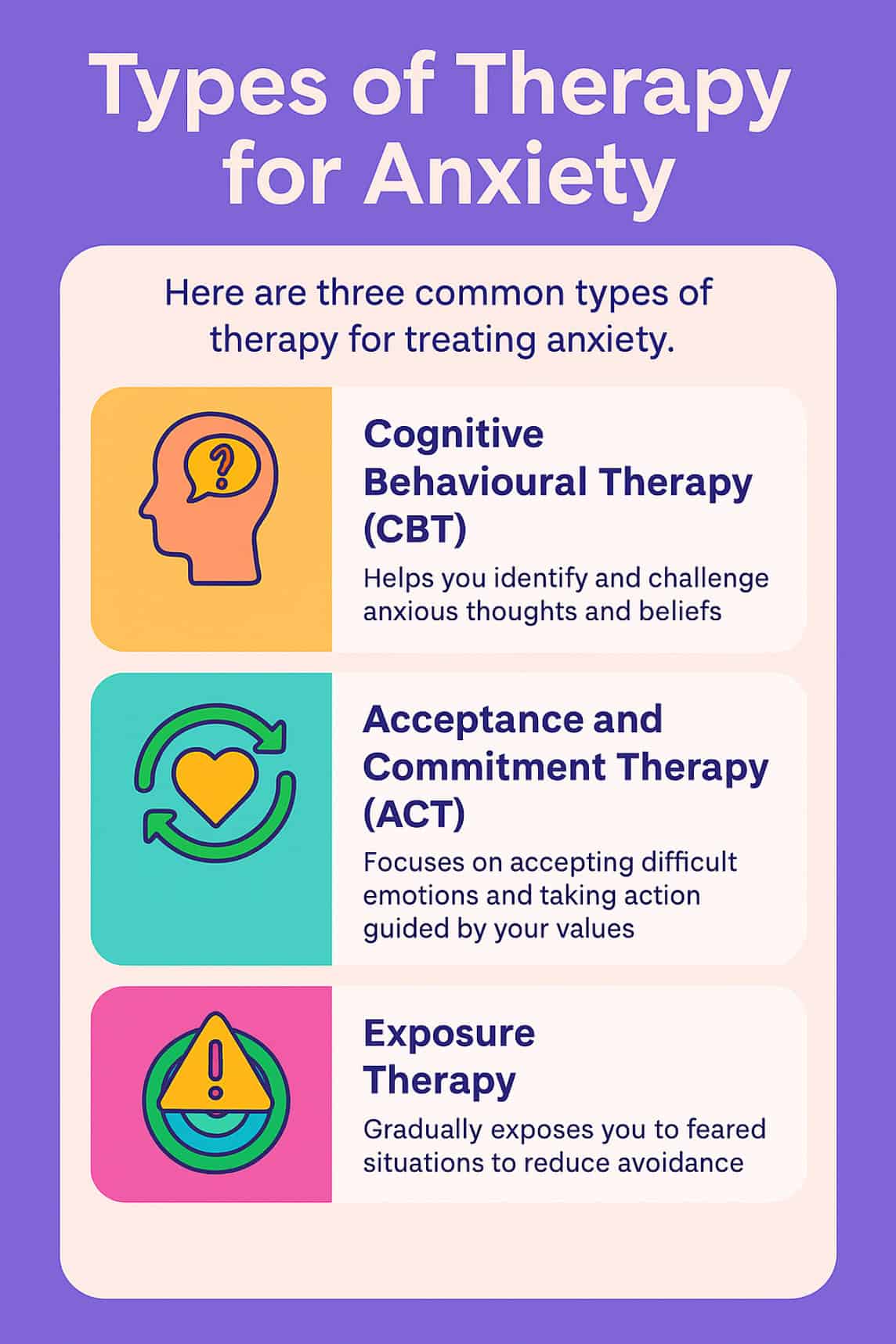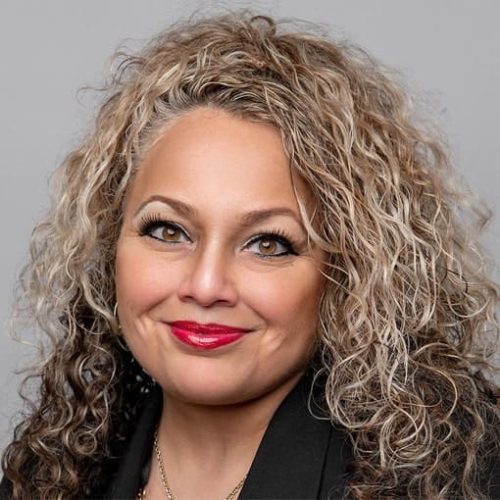
Key Takeaways for the Most Common Types of Anxiety Therapy.
- Each therapy approach targets anxiety in different but proven ways.
- Consistent practice between sessions boosts long-term results.
- You can choose the therapy that fits your recovery style, or blend them with your therapist’s guidance.
- These therapies can also support sober living by addressing cravings, avoidance, and emotional regulation.
🎯 The three most common and effective types of therapy for anxiety are:
- Cognitive Behavioural Therapy (CBT): Helps you identify and challenge anxious thoughts and beliefs that can also trigger cravings.
- Acceptance and Commitment Therapy (ACT): Focuses on accepting difficult emotions, reducing the urge to avoid or self-medicate, and taking action guided by your values.
- Exposure Therapy: Gradually exposes you to feared situations to rewire fear responses and reduce avoidance behaviours that often fuel substance use.
👉 Ready to take the next step? Learn more about anxiety therapy at AERCS and how to book your free 15-minute phone consultation.

The most common types of therapy for anxiety are Cognitive Behavioural Therapy (CBT), Acceptance and Commitment Therapy (ACT), and Exposure Therapy, each offering a unique roadmap to help you calm racing thoughts, steady your body, and break the avoidance cycles that keep anxiety, and often substance cravings, alive.
How Each Therapy Works at a Glance.
| Therapy | Core Idea | Best For | Key Benefit |
|---|---|---|---|
| CBT | Change anxious thinking patterns | People who overanalyse and “future trip” | Challenges distorted thoughts that spark both anxiety and cravings |
| ACT | Accept feelings, commit to values | Those who feel stuck fighting anxiety | Builds acceptance, reducing the urge to self-medicate |
| Exposure Therapy | Face fears in a planned way | Anyone avoiding places, objects, or memories | Rewires fear responses, lowering avoidance that can fuel substance use |
Cognitive Behavioural Therapy (CBT).
Why CBT Stands Out.
CBT is a gold-standard psychological treatment for anxiety. It teaches you to spot catastrophic predictions, test them against reality, and replace them with balanced thoughts.
Practical Tips:
- Thought Records: Write down anxious predictions and the evidence for and against them.
- Behavioural Experiments: If you fear a meeting will go poorly, attend and note the actual outcome.
- Link to Cravings: When you feel the urge to drink or vape, ask, “Which thought just spiked my anxiety?”
Quick Stat:
Randomised trials show CBT reduces anxiety symptoms by up to 60% after twelve sessions.
Acceptance and Commitment Therapy (ACT).
Why ACT Resonates with Many Canadians.
ACT teaches you to make room for uncomfortable feelings rather than fight them, then move toward what matters most, family, career growth, creative pursuits.
Practical Tips:
- Mindfulness Minute: Spend sixty seconds noticing breath, sounds, and sensations without judging them.
- Values Clarification: List top five life values, ask how each week’s actions line up.
- Urge Surfing: When anxiety or cravings rise, picture them like a wave you can ride until it passes.
Quick Stat:
Research shows ACT improves anxiety and stress tolerance in as few as eight sessions, with gains maintained six months later.
Exposure Therapy.
Why Facing Fear Beats Avoiding It.
Avoidance offers short relief but long-term costs. Exposure Therapy breaks that cycle by guiding you through gradual, controlled contact with feared cues.
Practical Tips:
- Fear Ladder: Rank triggers from least to most scary, practise moving up one step at a time.
- Sober Supports: Call a friend after each exposure task instead of reaching for substances.
- Post-Session Debrief: Note how quickly your fear drops during exposure to track progress.
Safety Note:
Therapists pace exposures carefully, so you never jump into overwhelming situations.
Choosing the Right Fit for Your Style
| Preference | Best Match | Why |
|---|---|---|
| Love clear plans and homework | CBT | Structured worksheets and measurable goals |
| Want to focus on meaning | ACT | Aligns skills with personal values |
| Ready to face specific fears head-on | Exposure | Directly reduces avoidance and physical panic |
If you are unsure, many therapists blend these methods, giving you a custom toolkit.
Bringing Therapy Skills into Daily Life.
- Schedule Daily Practise: Ten minutes of CBT thought work or ACT mindfulness adds up quickly.
- Track Wins and Setbacks: Use a simple journal to note anxiety levels and any substance cravings.
- Stay Consistent: Weekly sessions keep momentum, and missing appointments can stall progress.
3 Common Anxiety Therapies.
The leading types of therapy for anxiety, CBT, ACT, and Exposure Therapy, offer tried and tested ways to challenge thoughts, accept feelings, and face fears, all while supporting sober living. Choose the approach that matches your personality and goals, stay consistent, and watch anxiety lose its grip.
Ready to experience these therapies first-hand? Visit our Anxiety Therapy page and also book your free 15-minute phone consultation. Let’s find the strategy that fits you best.
What are the main types of therapy for anxiety?
The most researched types of therapy for anxiety are Cognitive Behavioural Therapy, Acceptance and Commitment Therapy, and Exposure Therapy.
How do I know which types of therapy for anxiety will suit me?
Consider whether you prefer structured thought work, mindfulness and values, or direct fear-facing, then choose the therapy that matches those needs. Your professional therapist can help guide you.
Can I combine different types of therapy for anxiety?
Yes, many therapists blend CBT, ACT, and exposure techniques for a personalised plan.
Are these types of therapy for anxiety available online in Ontario?
Most clinicians now offer virtual CBT, ACT, and Exposure Therapy sessions across Ontario and the GTA.
Do the types of therapy for anxiety help with substance cravings too?
Absolutely, CBT challenges craving-triggering thoughts, ACT reduces avoidance urges, and exposure lowers fear that can lead to self-medication.
Do You Need Anxiety Therapy?
Take this quick self-assessment to see if anxiety therapy could help you manage symptoms.Note: This questionnaire is educational only and does not replace a clinical assessment. If you wish to obtain professional guidance, please follow up with a licensed mental health professional.

